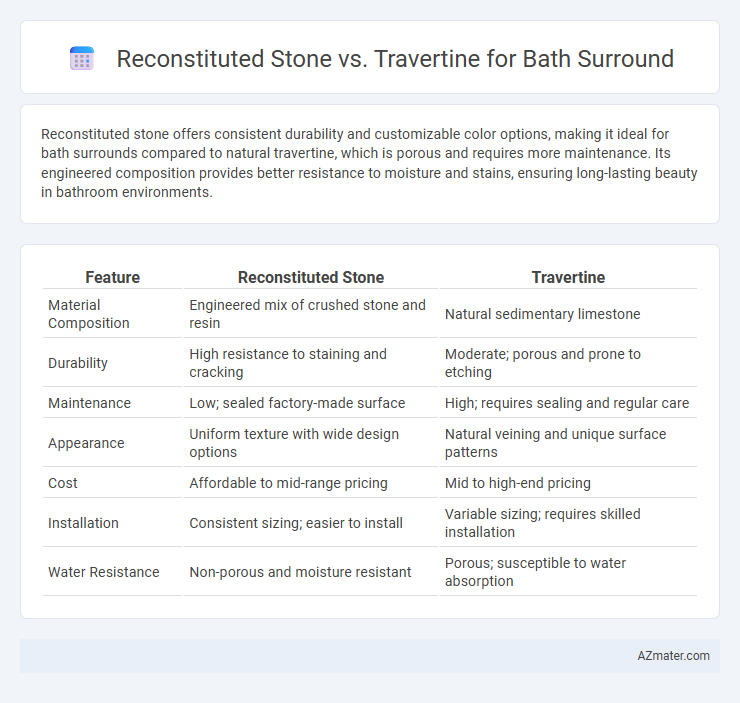Reconstituted stone offers consistent durability and customizable color options, making it ideal for bath surrounds compared to natural travertine, which is porous and requires more maintenance. Its engineered composition provides better resistance to moisture and stains, ensuring long-lasting beauty in bathroom environments.
Table of Comparison
| Feature | Reconstituted Stone | Travertine |
|---|---|---|
| Material Composition | Engineered mix of crushed stone and resin | Natural sedimentary limestone |
| Durability | High resistance to staining and cracking | Moderate; porous and prone to etching |
| Maintenance | Low; sealed factory-made surface | High; requires sealing and regular care |
| Appearance | Uniform texture with wide design options | Natural veining and unique surface patterns |
| Cost | Affordable to mid-range pricing | Mid to high-end pricing |
| Installation | Consistent sizing; easier to install | Variable sizing; requires skilled installation |
| Water Resistance | Non-porous and moisture resistant | Porous; susceptible to water absorption |
Introduction to Bath Surround Materials
Reconstituted stone offers a durable and cost-effective option for bath surrounds, combining natural stone aggregates with resin binders for enhanced strength and uniformity. Travertine, a natural limestone formed by mineral deposits, provides a classic, warm aesthetic with unique veining but requires higher maintenance due to its porosity and susceptibility to staining. Selecting between reconstituted stone and travertine for bath surrounds depends on desired appearance, budget, and durability requirements in wet environments.
What is Reconstituted Stone?
Reconstituted stone, also known as engineered stone, is a composite material made from crushed natural stone mixed with resins and pigments, designed to mimic the appearance of natural stone while offering enhanced durability and consistency. This material provides a non-porous surface that resists stains, scratches, and moisture, making it an excellent choice for bath surrounds where water exposure is constant. In comparison to travertine, a natural sedimentary stone known for its porous texture and variable patterns, reconstituted stone offers easier maintenance and a more uniform aesthetic for bathroom installations.
Understanding Travertine Stone
Travertine is a natural limestone characterized by its porous texture and warm, earthy tones, offering a classic, elegant appearance for bath surrounds. Unlike reconstituted stone, which is engineered from crushed stone and resins, travertine requires sealing to prevent moisture absorption and staining in wet environments. Its unique veining and natural pitting provide aesthetic depth but necessitate regular maintenance to preserve durability and prevent damage.
Visual Appeal: Comparing Aesthetics
Reconstituted stone offers a uniform appearance with customizable colors and patterns, providing a sleek and modern aesthetic ideal for contemporary bath surrounds. Travertine showcases natural veining and porous textures, creating a timeless, rustic charm that enhances classic bathroom designs. Choosing between the two depends on desired visual impact, with reconstituted stone delivering consistency and Travertine offering unique, organic beauty.
Durability and Maintenance Needs
Reconstituted stone offers superior durability and low maintenance for bath surrounds due to its engineered composition, which resists chipping, staining, and moisture absorption better than natural travertine. Travertine requires regular sealing to prevent water damage and is prone to etching and staining, making it less ideal for high-moisture bathroom environments. Choosing reconstituted stone reduces long-term upkeep costs and preserves aesthetic appeal with minimal effort.
Water Resistance and Suitability for Wet Areas
Reconstituted stone offers superior water resistance due to its engineered composition, making it highly suitable for wet areas like bath surrounds without absorbing moisture or sustaining damage. Travertine, a natural porous stone, requires sealing to enhance its water resistance, but even then, it remains more susceptible to staining and water infiltration over time. For long-term durability and minimal maintenance in wet environments, reconstituted stone is generally preferred over Travertine for bath surrounds.
Cost Comparison: Reconstituted Stone vs Travertine
Reconstituted stone typically costs between $30 and $50 per square foot, offering a budget-friendly alternative to natural travertine, which ranges from $45 to $80 per square foot. Installation expenses for reconstituted stone often remain lower due to its uniformity and ease of handling compared to the more labor-intensive cutting and fitting required for travertine. Overall, choosing reconstituted stone for a bath surround can reduce both material and installation costs by approximately 20% to 40% compared to travertine.
Installation Process and Considerations
Reconstituted stone offers a more uniform and lightweight option for bath surrounds, simplifying installation with its consistent dimensions and easier cutting compared to natural travertine, which often requires specialized tools and skill due to its porous and irregular surface. Travertine demands thorough sealing to prevent water absorption and staining, increasing preparation time, while reconstituted stone typically comes pre-sealed or requires minimal sealing, reducing maintenance during installation. Choosing between these materials depends on balancing installation complexity, durability requirements, and desired aesthetic, with reconstituted stone favoring faster, more predictable installation processes.
Eco-Friendliness and Sustainability Factors
Reconstituted stone offers superior eco-friendliness for bath surrounds due to its use of recycled aggregates and lower energy consumption during manufacturing compared to natural travertine, which involves quarrying and significant environmental disruption. Travertine extraction leads to habitat destruction and higher carbon emissions, while reconstituted stone often incorporates sustainable binders and repurposed materials, reducing landfill waste. Choosing reconstituted stone supports resource conservation and aligns with sustainable building practices emphasizing reduced ecological impact.
Which is Better for Your Bath Surround?
Reconstituted stone offers greater durability and uniformity in color and texture compared to natural travertine, making it an ideal choice for bath surrounds that require long-lasting performance and low maintenance. Travertine provides a unique, natural aesthetic with porous surfaces that may require sealing to prevent water damage and staining in humid bathroom environments. For bath surrounds, reconstituted stone is generally better due to its resistance to moisture and consistent appearance, while travertine suits those prioritizing natural stone's organic look and texture.

Infographic: Reconstituted stone vs Travertine for Bath Surround
 azmater.com
azmater.com